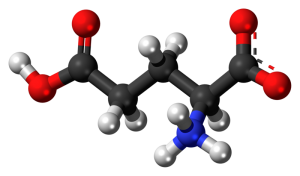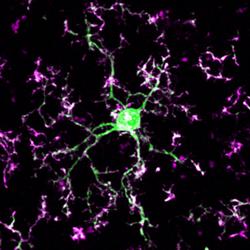
One of the main strengths of the Festival of Neuroscience is the British Neuroscience Association’s generosity towards their sister societies and sponsors. Having over fifty symposia, workshops and special events hosted by a diverse array of professional societies such as the Biochemical society, British Society of Neuroendocrinology, Association of British Neurologists amongst others, allow the delegate to explore both core and obscure domains of neuroscience from completely different perspectives. Eventually a more rounded three dimensional insight is crystallised about subjects ranging from computational neuroscience to management of common disorders in a clinical setting.
With a 378 pages book of abstracts, this review can only attempt to touch on a few of the main themes that had the highest profile and the reviewers found particularly interesting as clinicians.
Glutamate

The overwhelming majority of the pharmacological agents used in neurology and psychiatry exert their mode of action by enhancing or blocking one of the main neurotransmitters such as GABA, Dopamine, Serotonin and Acetylcholine. Glutamate and GABA are the main excitatory and inhibitory neurotransmitters respectively but whilst GABA agonists are integral part of neuropharmacology, only a handful of drugs can claim efficacy by influencing Glutamate (mainly through blockade).
Basic scientists have a favourable view of Glutamate as the main hero of synaptic plasticity and subsequently the most established and investigated concept of neural modulation: Long Term Potentiation LTP (as the Canadian Psychologist Donald Hebb puts it 50 years ago: If they fire together, they wire together). Graham Collingridge of the university of Bristol gave a detailed history of LTP and how it could be affected in his Plenary lecture; whilst many speakers showcased the recent advances in manipulating LTP mechanism to enhance and sometimes delete memories (M. Fanselow of UCLA, Z. Padamsey of Oxford University).
Speakers discussing Glutamate from a clinical perspective have a less favourable view, as its role in many pathological processes is well established. Neurodegeneration and epilepsy (M. Cunningham of the University of Newcastle) are two of the pathologies that were heavily covered. LTP is also believed to be the primary cellular mechanism priming addiction and chronic pain.
All neuroscientists seem to agree that a crude attempt to antagonise Glutamate action is bound to fail. Glutamate is used in more than 90% of synapses and even when it is not the dominant neurotransmitter (such as in the case of the basal ganglia with 70% Dopamine and 30% GABA synapses) Glutamate plays a major role regulating the action of these dominant neurotransmitters. A very impressive body of work is created now analysing how Glutamate pathways and cell signalling differ in the normal physiological states and how it turn into a potent cytotoxic killer in pathological processes. Targeting specific cell signalling molecules seem to be the rational way to influence a specific disease processes whilst maintaining Glutamate’s important action in maintaining a normal synaptic function.
Microglia

When Santiago Cajal coined the name Glia (glue in Greek) he was reflecting the view that Glial cells are basically fillers. The focus on the neurone as the primary place where interesting things happen seems to be unjustified after hearing the advances in understanding microglial function and how it goes wrong in disease processes. Two symposia were dedicated to microglia. Only a few number of speakers were interested in the classic role of microglia as a part of the CNS immune system; the focus now is to understand the role microglia play in neuroplasticity, as each cell survey more than 150 000 neurones in its patch, pruning and attacking the frail and inactive neurones and synapses as it goes. The more plastic a brain area is, the more abundant microglia are (brain stem have the lowest population of microglia as it is one of the least plastic areas).
Microglial proliferation is a classic feature of many pathologies; H. Perry of the University of Southampton believed that they play a key role in the pathogenesis of many degenerative diseases where their proliferation, aberrant morphology and spinal loss are key features. Focusing in the immune response with microglia at its heart seems to be a promising approach to further understand neurodegeneration. A UK based lab has a poster replicating last year’s Nature report by a Japanese group successfully producing microglia from human Induced Pluripotent Stem cells. A clearer understanding of the role of microglia is bound to happen thanks to this development.
Talking about stem cells, Andrea Brand of the University of Cambridge presented her work in trying to manipulate the dormant brain stem cells in fruit flies and is hoping that further understanding of the mechanisms controlling the transformation of the stem cells to different neural cell types may have important implications for humans.
Genetics and epigenetics
The mapping of the human genome in the turn of the millennium ushered the birth of a new domain for genetic studies, Genome Wide Association Studies (GWAS). This powerful tool is now widely used to establish the genetic co-relation of many diverse medical conditions. Three symposia showcased the recent trends in genetics and epigenetics research with language disorders, epilepsy and developmental disorders discussed. GWAS among other methods showed how complex and diverse the genetic changes can be. The iconic FOXP2 gene seems to be only a small part of the story of language development, however it remains the most studied and understood gene related to speech disorders. S. Vernes of the Max Planck Institute gave an excellent up to date review of the current understanding of that gene.
Epigenetics was the buzz word in many presentations and posters with a focus on how in utero or early life stress is strongly linked to adult pathology via epigenetic mechanisms. However, well established genetic links continued to dominate the research landscape with a single gene such as APOE 2 and its link to Alzheimer’s Disease having a whole symposium discussing the molecular abnormalities and the potential targets for therapy.
We feel that at these times of unprecedented pressure in clinical practice, it is more important than ever to take a step back and try to catch up with the fundamentals of neuroscience and have an insight of how the landscape and paradigms of neuroscience and subsequently clinical practice are changing.
The next Festival of Neuroscience will be held in Dublin in 2019.